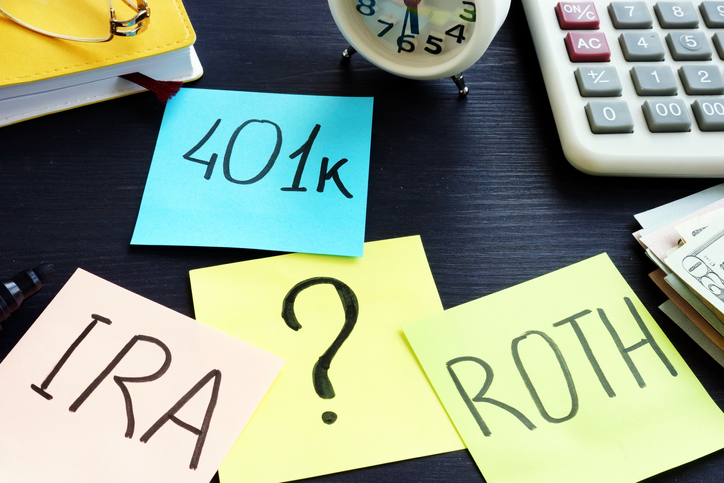Roth IRA and 401(k) accounts are two popular retirement savings options, each offering unique features and benefits. A Roth IRA is an individual retirement account that allows for after-tax contributions, providing tax-free withdrawals in retirement. In contrast, a 401(k) is an employer-sponsored plan where contributions are often made pre-tax, deferring taxes until withdrawal. Understanding the differences between Roth IRA vs 401(k) can help you decide which aligns better with your financial goals, contribution preferences and future tax considerations.
For more help with retirement planning and other financial issues, consider working with a financial advisor.
What Is a Roth IRA?
A Roth IRA is an individual retirement account (IRA) that you set up with a financial institution, like a bank or brokerage.
You fund Roth IRAs with your after-tax money, which means you can’t deduct your contributions at tax time. However, when it comes time to withdraw your savings during retirement, that income isn’t taxable, assuming certain conditions are met.
A Roth IRA differs from a traditional IRA, which you fund with pre-tax money. You then pay regular income taxes on your traditional IRA withdrawals during retirement.
What Is a 401(k)?
You may be more familiar with 401(k) plans.
These are plans that employers sponsor, so you don’t have to open and fund one by yourself. You contribute to a 401(k) by designating a portion of each paycheck to go toward your plan. Since you fund a 401(k) with pre-tax income, you pay taxes on that money when you make withdrawals during retirement.
It’s important to note that 401(k) plans can also come with an employer match program. Employers can choose to match an employee’s contribution, often up to a certain percentage of the employee’s income.
A common example of this match program includes an employer matching 50% of an employee’s contribution, up to 6% of the employee’s salary. However, the exact terms of the match depend on each employer.
As an extra advantage, your employer match does not count toward your 401(k) limit.
Roth IRA vs. 401(k)
On the surface, Roth IRAs and 401(k)s don’t have too much in common, other than they are both a tax-advantaged way to save for retirement.
Since you can have both a Roth IRA and a 401(k), it can help to compare their similarities and differences so you can determine which account is best for you.
Eligibility and Contribution Limits
Your eligibility for a 401(k) plan simply depends on whether your employer offers one. Without an employer’s help, a Roth IRA may not be available to everyone. You will have to find the right institution for your account, and some institutions only accept applicants with high deposits, limiting their products to high-net-worth individuals.
It’s important to note, however, that Roth IRAs offer a savings option for those with lower income. This is because you fund a Roth IRA with after-tax money, making your withdrawals tax-free. This structure applies to people who expect to be in a higher tax bracket in retirement.
Plus, Roth IRA rules and limitations tend to phase out higher earners. For tax year 2026, total contributions to Roth and traditional IRAs cannot exceed $7,500, or $8,600 for those 50 and older.
401(k) plans, on the other hand, have much higher contribution limits. For tax year 2026, you can contribute up to $24,500 (or $32,500 for those 50 and older) to your 401(k).
Don’t forget that if your employer matches your 401(k) contribution, their match does not count toward that limit. Instead, you must track total annual 401(k) contributions so they do not exceed the lesser of 100% of your salary or $72,000 ($77,500 for those 50 and older) in 2026.
Lastly, in 2026, people between 60 and 63 years old can make up to $11,250 in catch-up contributions to 401(k)s and similar workplace accounts, instead of the standard $7,500. Known as super catch-up contributions, these additional contributions were established as part of 2022’s SECURE 2.0 Act.
401(k) vs. Roth IRA: Tax Treatment & Distributions

A big difference between Roth IRAs and 401(k)s lies in their tax treatment.
You fund Roth IRAs with after-tax income, meaning your withdrawals are not taxable retirement income. Conversely, you fund 401(k)s with pre-tax income, which makes your 401(k) withdrawals subject to taxation in retirement.
You must begin taking required minimum distributions (RMDs) from your 401(k) at age 73, or 75 if you were born in 1960 or later. These RMDs are taxable.
However, this does not apply to Roth IRAs, which have already been taxed. Therefore, there is no need to take RMDs from a Roth IRA.
If you’re under the age of 59 ½ and have had a Roth IRA for at least five years, you can withdraw your contributions – but no earnings – at any time penalty-free. The same does not apply to 401(k) plans, which face a 10% penalty on withdrawals before age 59 ½.
Use our RMD Calculator to see how your balance and age affect your annual distribution.
Required Minimum Distribution (RMD) Calculator
Estimate your next RMD using your age, balance and expected returns.
RMD Amount for IRA(s)
RMD Amount for 401(k) #1
RMD Amount for 401(k) #2
About This Calculator
This calculator estimates RMDs by dividing the user's prior year's Dec. 31 account balance by the IRS Distribution Period based on their age. Users can enter their birth year, prior-year balances and an expected annual return to estimate the timing and amount of future RMDs.
For IRAs (excluding Roth IRAs), users may combine balances and take the total RMD from one or more accounts. For 401(k)s and similar workplace plans*, RMDs must be calculated and taken separately from each account, so balances should be entered individually.
*The IRS allows those with multiple 403(b) accounts to aggregate their balances and split their RMDs across these accounts.
Assumptions
This calculator assumes users have an RMD age of either 73 or 75. Users born between 1951 and 1959 are required to take their first RMD by April 1 of the year following their 73rd birthday. Users born in 1960 and later must take their first RMD by April 1 of the year following their 75th birthday.
This calculator uses the IRS Uniform Lifetime Table to estimate RMDs. This table generally applies to account owners age 73 or older whose spouse is either less than 10 years younger or not their sole primary beneficiary.
However, if a user's spouse is more than 10 years younger and is their sole primary beneficiary, the IRS Joint and Last Survivor Expectancy Table must be used instead. Likewise, if the user is the beneficiary of an inherited IRA or retirement account, RMDs must be calculated using the IRS Single Life Expectancy Table. In these cases, users will need to calculate their RMD manually or consult a finance professional.
For users already required to take an RMD for the current year, the calculator uses their account balance as of December 31 of the previous year to compute the RMD. For users who haven't yet reached RMD age, the calculator applies their expected annual rate of return to that same prior-year-end balance to project future balances, which are then used to estimate RMDs.
This RMD calculator uses the IRS Uniform Lifetime Table, but certain users may need to use a different IRS table depending on their beneficiary designation or marital status. It's the user's responsibility to confirm which table applies to their situation, and tables may be subject to change.
Actual results may vary based on individual circumstances, future account performance and changes in tax laws or IRS regulations. Estimates provided by this calculator do not guarantee future distribution amounts or account balances. Past performance is not indicative of future results.
SmartAsset.com does not provide legal, tax, accounting or financial advice (except for referring users to third-party advisers registered or chartered as fiduciaries ("Adviser(s)") with a regulatory body in the United States). Articles, opinions and tools are for general informational purposes only and are not intended to provide specific advice or recommendations for any individual. Users should consult their accountant, tax advisor or legal professional to address their particular situation.
Investment Options
Finally, Roth IRAs and 401(k)s differ in their investment options.
With a 401(k), you are limited to the investment options your employer has chosen. Your options ultimately depend on your employer, but you generally cannot choose any investment you fancy.
A Roth IRA provides more control over your investment accounts. Since you (or a robo-advisor) manage the account, you choose its asset allocation. This can give you greater flexibility to choose low-cost mutual funds and ETFs instead of the higher costs you may face with your employer’s plan.
| Category | Roth IRA (2026) | Roth 401(k) (2026) |
|---|---|---|
| Eligibility | Generally those in lower tax brackets | Dependent on employer plan, if any |
| Contribution Limits | Maximum contributions: $7,500 Maximum contributions for ages 50 and older: $8,600 | Maximum employee contributions: $24,500 Maximum employee contributions for ages 50 and older: $32,500 Maximum employee super catch-up contributions ages 60-63: $34,750 Maximum total contributions: the lesser of 100% of salary or $72,000 Maximum total contributions ages 50 and older: $77,500 |
| Funded By | After-tax income. | After-tax employee contributions |
| Tax Treatment | Qualified withdrawals are not taxable. | Employer contributions are pre-tax. Withdrawals of employer contributions are taxable income. |
| Distributions (Withdrawals) | No required minimum distributions during the account owner’s lifetime. Early withdrawals may trigger taxes and penalties. | Required minimum distributions begin at age 73 (age 75 if born in 1960 or later). Early withdrawals result in income tax plus a 10% penalty. |
| Who Selects Investments | Investor or their advisor or robo-advisor | Employer |
| Employer Match | No | Yes |
Rollovers, Portability and Account Consolidation
Roth IRAs are fully portable and remain under your control, regardless of employment changes. Once the account is opened, it stays with the same financial institution unless you choose to move it. Changing jobs does not affect contribution rules, investment access or account ownership.
A 401(k) is tied to an employer, which means switching jobs often triggers a decision about what to do with the account balance. Former employees may leave assets in the old plan, roll them into a new employer’s plan or move them into an IRA. Each option has administrative and tax considerations tied to plan rules.
Roth 401(k) balances can typically be rolled into a Roth IRA. This type of rollover allows after-tax assets to remain in a tax-free growth structure while removing required minimum distributions that apply to employer plans. The rollover does not create additional tax if handled as a direct transfer.
Over time, consolidating old workplace plans into an IRA can reduce the number of accounts you track and centralize investment decisions. Account consolidation can also affect withdrawal sequencing, beneficiary designations and long-term distribution planning later in retirement.
Bottom Line

Knowing the differences between Roth IRAs vs. 401(k) plans can help you make better decisions regarding your retirement savings. These plans can also be ideal partner accounts: you can have a 401(k) through your employer and a Roth IRA with a financial institution of your choosing, provided they offer Roth accounts. Then in retirement, you’ll have both taxable and nontaxable income to withdraw.
Tips on Getting Ready for Retirement
- The most important part about saving for retirement is that it’s never too early to start! True, retirement may not be on many 20-somethings’ minds, but the earlier you start saving, the more money you can have in retirement.
- Once you’ve started saving for retirement, try not to compare yourself to your neighbors wondering if your savings are normal. It’s more important to tailor your savings plans to your own current financial situation and your retirement goals.
- Retirement planning can be complex and overwhelming, but a financial advisor can help demystify the process. Finding a financial advisor doesn’t have to be hard. SmartAsset’s free tool matches you with vetted financial advisors who serve your area, and you can have a free introductory call with your advisor matches to decide which one you feel is right for you. If you’re ready to find an advisor who can help you achieve your financial goals, get started now.
Photo credit: ©iStock.com/gradyreese, ©iStock.com/CatLane, ©iStock.com/designer491
